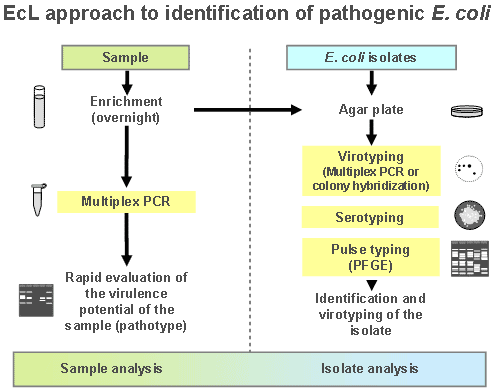Diagnostic strategies
Samples may be sent to us for initial rapid and highly sensitive detection of pathogenic E. coli (pathotyping) using an enrichment multiplex PCR tailored to the specific animal species, especially pigs, cattle, dogs and cats, rabbits, and humans. Positive samples may be further examined for the isolation of the pathogenic E. coli and complete analysis (virotyping) for a wide range of up to 100 or more virulence factors using multiplex PCR and/or colony hybridization, allowing us to confirm the pathogenic potential of the individual isolates. O serotyping and H typing may be carried out to help in the identification of pathogenic isolates. The same analysis can be performed on isolates sent to us from other laboratories. The antibioresistance profile of the isolates may also be determined. Further molecular characterization by pulsefield gel electrophoresis (pulsetyping) may be carried out, for the identification of emerging virotypes and clones and the epidemiological tracking of these and other established pathogenic E. coli. This approach will permit a rapid response in producing new vaccine strains and effective immunoglobulin therapies and facilitating molecular epidemiological studies.
An outline of our approach to the preliminary identification of samples containing pathogenic E. coli and to the definitive identification of the virotype of the isolate are shown in the following diagram.

 Top of page
Top of page





